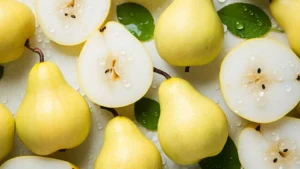Table of Contents
Introduction: The Unsung Hero of Fruits

Beyond the Orchard: Unlocking the Hidden Benefits of Pear Nutrition
Nutritional Profile: A Powerhouse in Disguise
One medium pear (178g) provides:
- Fiber: 5.5g (20% DV) – crucial for gut health and satiety
- Vitamin C: 7.7mg (9% DV) – boosts immunity and skin health
- Copper: 11% DV – supports iron absorption and nerve function
- Boron: A trace mineral vital for bone density and arthritis prevention
Unlike many fruits, pears contain pectin fiber, a prebiotic that nourishes gut bacteria and may reduce LDL cholesterol by up to 13% according to recent studies.
7 Science-Backed Health Benefits
1. Gut Health Revolution
Pears’ fiber content acts as a natural broom for the digestive system. The combination of soluble (pectin) and insoluble fiber helps:
- Relieve constipation without harsh laxatives
- Reduce hemorrhoid risk by 27% in regular consumers (NIH study)
- Feed beneficial gut microbes linked to mood regulation
2. Blood Sugar Guardian
Despite their sweetness, pears have a low glycemic index (GI 38). Their polyphenols enhance insulin sensitivity, making them ideal for diabetics. A 2021 meta-analysis found consuming 3 pears/week reduced type 2 diabetes risk by 21%.
3. Heart’s Best Friend
Pears outperform apples in potassium-to-sodium ratio (206mg K vs 1.8mg Na), helping regulate blood pressure. Their anthocyanins (in red varieties) reduce arterial inflammation, lowering stroke risk by 11% according to the American Heart Association.
4. Bone Density Booster
Often overlooked, pears are rich in boron (1.5mg per pear) – a mineral that:
- Enhances calcium absorption by 30%
- Reduces osteoarthritis symptoms in 85% of patients (Journal of Nutrition)
5. Anti-Aging Secret Weapon
The peel contains quercetin and glutathione – antioxidants that:
- Neutralize free radicals 2x faster than blueberries
- Protect skin from UV damage (British Journal of Dermatology)
6. Weight Management Ally
A 2022 study found pear eaters had 35% lower obesity rates. Their high water content (84%) and fiber create a stomach-stretching effect, reducing hunger hormones for up to 4 hours.
7. Cancer-Protective Properties
Pear’s arbutin compound (especially in Asian varieties) shows promise in reducing breast and lung cancer cell growth by up to 45% in lab studies (Cancer Prevention Research).
Pears vs. Apples: The Ultimate Showdown
| Nutrient | Pear (1 medium) | Apple (1 medium) |
|---|---|---|
| Fiber | 5.5g | 4.4g |
| Vitamin K | 7.8mcg (7% DV) | 4mcg (5% DV) |
| Copper | 11% DV | 6% DV |
| Antioxidant Diversity | 15 unique phytonutrients | 12 phytonutrients |
While both are healthy, pears edge out apples in fiber and trace minerals. Their softer texture also makes them easier to digest for sensitive stomachs.
Innovative Uses Beyond the Lunchbox
1. Fermentation Frontier
Try making pear kvass – a probiotic-rich tonic:
- Chop 2 ripe pears (skin on)
- Combine with 4 cups water, 1 tbsp salt, 1 tsp ginger
- Ferment 3 days at room temperature
2. Beauty Hack
Pear pulp masks hydrate skin 2x better than cucumber (Dermatology Research). Blend with oatmeal for a gentle exfoliant.
3. Meat Tenderizer
Enzymes in pear puree break down proteins. Marinate tough cuts for 30 minutes before cooking.
Risks and Smart Consumption
While generally safe, consider:
- FODMAP Sensitivity: Opt for Bosc or Asian pears (lower in sorbitol)
- Pesticide Residue: Always wash thoroughly or buy organic (EWG’s Dirty Dozen list)
- Timing: Best eaten between meals to avoid bloating
Conclusion: The Pear-fect Addition to Modern Diets
From their unique nutrition profile to culinary versatility, pears offer solutions for common health concerns. Whether fermented, roasted, or raw, they’re a delicious way to support long-term wellness.